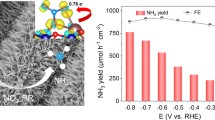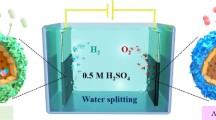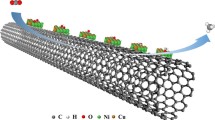Abstract
Oxygen evolution reaction (OER), as the primary anodic reaction, plays a critical role in many electrochemical energy conversion processes. As the state-of-the-art OER catalysts, iridium-based materials are largely hindered from practical applications mainly due to the extreme scarcity of iridium. Here we demonstrate the successful fabrication of boron-doped amorphous iridium oxide (IrOx-B) via a facile boric acid-assisted method, which realizes an ultrahigh OER mass activity of 2779 A g −1Ir at 300 mV overpotential, representing one of the best acidic OER catalysts reported so far. It is found that boric acid can not only facilitate the exposure of Ir, but also dope the amorphous IrOx with a form of metaborate, which could further modify the electronic and local ligand structure of Ir for the improved intrinsic activity. Interestingly, the reported strategy is universal that can be applied to improve other metal oxide OER catalysts, highlighting a versatile strategy for creating high-performance electro-catalysts with ultrahigh mass activity for OER and beyond.
摘要
析氧反应(OER)作为一种主要的阳极反应, 在许多电化学能量转换过程中起到了重要的作用. 尽管铱(Ir)基材料是目前最先进的OER催化剂, 其稀缺性很大程度上限制了该类材料的实际应用. 在此, 我们利用简便的硼酸辅助法成功制备了硼掺杂的无定形氧化铱(IrOx-B). 该催化剂在300 mV过电位处展现出2779 A g−1的超高OER质量活性, 是已报道的最佳酸性OER催化剂之一. 我们发现硼酸不仅可以促进Ir位点的暴露, 还能够以偏硼酸根的形式掺杂进入无定形IrOx中, 并进一步优化Ir的电子与配位结构, 进而实现本征活性的提升. 有趣的是, 这种方法具有一定的普适性, 能够提升其他金属氧化物催化剂的OER催化活性. 这为制备高质量活性的OER电催化剂提供了一种通用的策略.
Similar content being viewed by others
References
Jiao Y, Zheng Y, Jaroniec M, et al. Design of electrocatalysts for oxygen- and hydrogen-involving energy conversion reactions. Chem Soc Rev, 2015, 44: 2060–2086
Hunter BM, Gray HB, Müller AM. Earth-abundant heterogeneous water oxidation catalysts. Chem Rev, 2016, 116: 14120–14136
Zhou LQ, Ling C, Zhou H, et al. A high-performance oxygen evolution catalyst in neutral-pH for sunlight-driven CO2 reduction. Nat Commun, 2019, 10: 4081
Yao Q, Huang B, Zhang N, et al. Channel-rich RuCu nanosheets for pH-universal overall water splitting electrocatalysis. Angew Chem Int Ed, 2019, 58: 13983–13988
Seh ZW, Kibsgaard J, Dickens CF, et al. Combining theory and experiment in electrocatalysis: Insights into materials design. Science, 2017, 355: eaad4998
Rossmeisl J, Qu ZW, Zhu H, et al. Electrolysis of water on oxide surfaces. J Electroanal Chem, 2007, 607: 83–89
Koper MTM. Thermodynamic theory of multi-electron transfer reactions: Implications for electrocatalysis. J Electroanal Chem, 2011, 660: 254–260
Seitz LC, Dickens CF, Nishio K, et al. A highly active and stable IrOx/SrIrO3 catalyst for the oxygen evolution reaction. Science, 2016, 353: 1011–1014
Cherevko S, Geiger S, Kasian O, et al. Oxygen and hydrogen evolution reactions on Ru, RuO2, Ir, and IrO2 thin film electrodes in acidic and alkaline electrolytes: A comparative study on activity and stability. Catal Today, 2016, 262: 170–180
Reier T, Oezaslan M, Strasser P. Electrocatalytic oxygen evolution reaction (OER) on Ru, Ir, and Pt catalysts: A comparative study of nanoparticles and bulk materials. ACS Catal, 2012, 2: 1765–1772
Jiang B, Guo Y, Kim J, et al. Mesoporous metallic iridium nanosheets. J Am Chem Soc, 2018, 140: 12434–12441
Pi Y, Zhang N, Guo S, et al. Ultrathin laminar Ir superstructure as highly efficient oxygen evolution electrocatalyst in broad pH range. Nano Lett, 2016, 16: 4424–4430
Cheng Z, Huang B, Pi Y, et al. Partially hydroxylated ultrathin iridium nanosheets as efficient electrocatalysts for water splitting. Natl Sci Rev, 2020, 7: 1340–1348
Alia SM, Shulda S, Ngo C, et al. Iridium-based nanowires as highly active, oxygen evolution reaction electrocatalysts. ACS Catal, 2018, 8: 2111–2120
Luo F, Hu H, Zhao X, et al. Robust and stable acidic overall water splitting on Ir single atoms. Nano Lett, 2020, 20: 2120–2128
Wang Q, Huang X, Zhao ZL, et al. Ultrahigh-loading of Ir single atoms on NiO matrix to dramatically enhance oxygen evolution reaction. J Am Chem Soc, 2020, 142: 7425–7433
Yang XF, Wang A, Qiao B, et al. Single-atom catalysts: A new frontier in heterogeneous catalysis. Acc Chem Res, 2013, 46: 1740–1748
Chen Y, Li H, Wang J, et al. Exceptionally active iridium evolved from a pseudo-cubic perovskite for oxygen evolution in acid. Nat Commun, 2019, 10: 572
Gao J, Xu CQ, Hung SF, et al. Breaking long-range order in iridium oxide by alkali ion for efficient water oxidation. J Am Chem Soc, 2019, 141: 3014–3023
Geiger S, Kasian O, Ledendecker M, et al. The stability number as a metric for electrocatalyst stability benchmarking. Nat Catal, 2018, 1: 508–515
Zhang B, Zheng X, Voznyy O, et al. Homogeneously dispersed multimetal oxygen-evolving catalysts. Science, 2016, 352: 333–337
Korotcov AV, Huang YS, Tiong KK, et al. Raman scattering characterization of well-aligned RuO2 and IrO2 nanocrystals. J. Raman Spectrosc, 2007, 38: 737–749
Nong HN, Gan L, Willinger E, et al. IrOx core-shell nanocatalysts for cost- and energy-efficient electrochemical water splitting. Chem Sci, 2014, 5: 2955–2963
Lettenmeier P, Wang L, Golla-Schindler U, et al. Nanosized IrOx-Ir catalyst with relevant activity for anodes of proton exchange membrane electrolysis produced by a cost-effective procedure. Angew Chem Int Ed, 2016, 55: 742–746
Nong HN, Reier T, Oh HS, et al. A unique oxygen ligand environment facilitates water oxidation in hole-doped IrNiOx core-shell electrocatalysts. Nat Catal, 2018, 1: 841–851
Kim YT, Lopes PP, Park SA, et al. Balancing activity, stability and conductivity of nanoporous core-shell iridium/iridium oxide oxygen evolution catalysts. Nat Commun, 2017, 8: 1449
Danilovic N, Subbaraman R, Chang KC, et al. Activity-stability trends for the oxygen evolution reaction on monometallic oxides in acidic environments. J Phys Chem Lett, 2014, 5: 2474–2478
Geiger S, Kasian O, Mingers AM, et al. Catalyst stability benchmarking for the oxygen evolution reaction: the importance of backing electrode material and dissolution in accelerated aging studies. ChemSusChem, 2017, 10: 4140–4143
Freakley SJ, Ruiz-Esquius J, Morgan DJ. The X-ray photoelectron spectra of Ir, IrO2 and IrCl3 revisited. Surf Interface Anal, 2017, 49: 794–799
Pfeifer V, Jones TE, Velasco Vélez JJ, et al. The electronic structure of iridium and its oxides. Surf Interface Anal, 2016, 48: 261–273
Guo F, Wu Y, Chen H, et al. High-performance oxygen evolution electrocatalysis by boronized metal sheets with self-functionalized surfaces. Energy Environ Sci, 2019, 12: 684–692
Pfeifer V, Jones TE, Wrabetz S, et al. Reactive oxygen species in iridium-based OER catalysts. Chem Sci, 2016, 7: 6791–6795
Sanchez Casalongue HG, Ng ML, Kaya S, et al. In situ observation of surface species on iridium oxide nanoparticles during the oxygen evolution reaction. Angew Chem Int Ed, 2014, 53: 7169–7172
Spöri C, Briois P, Nong HN, et al. Experimental activity descriptors for iridium-based catalysts for the electrochemical oxygen evolution reaction (OER). ACS Catal, 2019, 9: 6653–6663
Acknowledgements
The authors thank beamline BL14W1 (Shanghai Synchrotron Radiation Facility) for providing the beam time. This work was financially supported by the Ministry of Science and Technology (2017YFA0208200 and 2016YFA0204100), the National Natural Science Foundation of China (22025108 and 51802206), the Natural Science Foundation of Jiangsu Province (BK20180846), the Priority Academic Program Development of Jiangsu Higher Education Institutions (PAPD), the Project of Scientific and Technologic Infrastructure of Suzhou (SZS201905) and the Start-up Supports from Xiamen University.
Author information
Authors and Affiliations
Contributions
Huang X and Shao Q proposed and supervised the project. Cheng Z and Pi Y conceived and designed the experiments. Cheng Z carried out the experiments and wrote the manuscript. Huang X, Shao Q and Pi Y revised the manuscript. All authors contributed to the general discussion.
Corresponding author
Additional information
Zifang Cheng is currently pursuing his Master degree at the College of Chemistry, Chemical Engineering and Materials Science, Soochow University under the supervision of Prof. Xiaoqing Huang. He received his Bachelor degree (2018) from Soochow University. His present research interests mainly focus on the design of noble metal nanomaterials for energy conversion applications.
Xiaoqing Huang is currently a Professor at the College of Chemistry and Chemical Engineering, Xiamen University. He obtained his BSc degree in chemistry education from Southwest Normal University (2005) and PhD degree in organic chemistry from Xiamen University (2011) under the supervision of Profs Nanfeng Zheng and Lansun Zheng. Then he joined Profs Yu Huang and Xiangfeng Duan’s group as a postdoctoral research associate (2011.9–2014.6) at the University of California, Los Angeles. His current research interests are in the design of nanoscale materials for heterogenous catalysis, electrocatalysis, energy conversion and beyond.
Conflict of interest
The authors declare no conflict of interest.
Rights and permissions
About this article
Cite this article
Cheng, Z., Pi, Y., Shao, Q. et al. Boron-doped amorphous iridium oxide with ultrahigh mass activity for acidic oxygen evolution reaction. Sci. China Mater. 64, 2958–2966 (2021). https://doi.org/10.1007/s40843-021-1687-5
Received:
Accepted:
Published:
Issue Date:
DOI: https://doi.org/10.1007/s40843-021-1687-5




